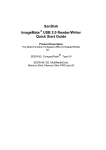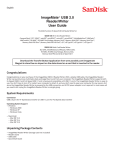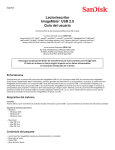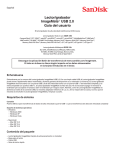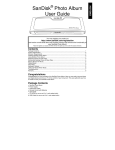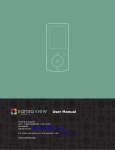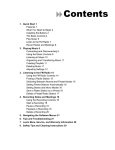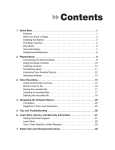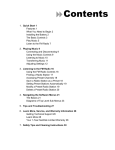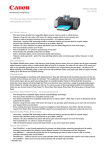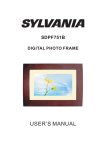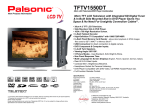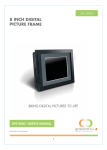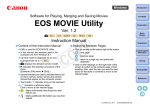Download ImageMate 12-in-1 Reader/Writer User Guide
Transcript
ImageMate® 12-in-1 Reader/Writer User Guide Model Number SDDR-89 Product Description The Multi-Function Hi-Speed USB 2.0 Reader/Writer CompactFlash® Type I/II, SDTM, miniSDTM, MultiMediaCardTM, RS-MMCTM, Memory StickTM, Memory Stick PROTM, Memory Stick DuoTM, Memory Stick PRO DuoTM, SmartMediaTM and xD Congratulations Congratulations on your purchase of the ImageMate USB 2.0 12-in-1 Reader/Writer. With a simple USB cable, the ImageMate 12-in-1 Reader/Writer can quickly move multimedia data and large files to and from your computer. The ImageMate 12-in-1 Reader/Writer supports both Hi-Speed USB 2.0 and Full Speed USB 1.1 and is backward compatible with USB 1.1 ports. The ImageMate 12-in-1 Reader/Writer is easy to use. You don’t have to turn off or restart your computer to attach it, and you don’t need to open your computer for any reason. And since the ImageMate 12-in-1 Reader/Writer is powered by the USB connection, an AC/DC power adapter is not required. In most cases, all you need to do is plug the ImageMate 12-in-1 Reader/Writer in and get going. System Requirements Connection • USB 2.0 port for Hi-Speed data transfer (or USB 1.1 port for Full Speed data transfer) Operating System Support • • Windows • Windows 98SE (driver installation required) • Windows ME • Windows 2000 • Windows XP Macintosh • OS 9.2+ • OS 10.1.2+ Unpacking Package Contents • • • • ImageMate 12-in-1 Reader/Writer with docking station (storage media not included) Installation CD with Windows 98SE driver, button application (Media Card Companion) and User Guide Extra USB travel cable User Guide Checking 1. Unpack the packaging. Make sure you have everything listed in the PACKAGE CONTENTS. 2. Check your system requirements. Refer to SYSTEM REQUIREMENTS or the outside of the packaging. 3. Locate the USB port on your computer. See UNDERSTANDING. 2 Understanding What’s a USB port? The Universal Serial Bus (USB) port is an easy way to connect a new device like the ImageMate 12-in-1 Reader/Writer to your computer. Connecting a device to the USB port doesn’t require that you open your computer to install an add-in card or set complicated switches. You just plug it in and get started. How do I find the USB port? The USB ports are often located on the front or back of your PC, or on a USB hub. On a laptop computer or a Macintosh, the USB port may be located on the side. The USB port looks like this: What is the difference between Hi-Speed USB 2.0 and Full Speed USB 1.1? Hi-Speed USB 2.0 supports the transfer of data up to 480 megabits per second (Mbps), and Full Speed USB 1.1 supports data transfer up to 12 Mbps. Hi-Speed USB 2.0 provides a dramatic improvement in data transfer performance compared to Full Speed USB 1.1. USB 2.0 is backward compatible with USB 1.1 ports. The ImageMate 12-in-1 Reader/Writer supports both USB 2.0 and USB 1.1. Installing Before connecting the ImageMate 12-in-1 Reader/Writer to your computer, you may need to install the device driver. You can skip this section if your operating system is Windows XP, ME, Windows 2000 with Service Pack 3, or Mac OS 10.1.2+ and proceed to Installing the Button Application. Install the Windows 98SE and Windows 2000 driver (for systems with Windows 2000 and with SP1 or SP2 installed) 1. Insert the CD included with the ImageMate 12-in-1 Reader/Writer into the CD-ROM of your computer. 2. Left-click on the START menu and open the RUN menu. Click BROWSE to locate the drive letter of your CD-ROM. 3. Select the setup.exe file and click OK. Follow the on-screen directions. Install the Macintosh 9.2.X driver: 1. Install the CD included with the ImageMate 12-in-1 Reader/Writer into the CD-ROM of your computer. 2. Double-click the CD-ROM icon on the desktop and then run the USB Reader Installer application for your Macintosh operating system. The Read Me file opens first. 3. Click Continue. 4. In the Installer Dialog, select USB Reader Installer in the drop-down menu and then click Install to install the device driver. 5. Follow the on-screen directions. Installing the Button Application (Media Card Companion, only for Windows) 1. Insert the CD included with the ImageMate 12-in-1 Reader/Writer device into the CD-ROM of your computer. 2. Left-click on the START menu and open the RUN menu. Click BROWSE to locate the drive letter of your CD-ROM. 3. Select the \Button Application\setup.exe file and click OK. Follow the on-screen directions. 3 Connecting Connecting the ImageMate 12-in-1 Reader/Writer to the USB port is simple. You don’t need to turn off or restart your computer when attaching the ImageMate 12-in-1 Reader/Writer. Since the ImageMate 12-in-1 Reader/Writer is powered by the USB connection, an AC/DC power adapter is not needed. Before connecting the ImageMate 12-in-1 Reader/Writer, complete the device driver installation. See INSTALLING. There are two ways to connect your ImageMate 12-in-1 Reader/Writer to your computer: 1. Insert the ImageMate 12-in-1 Reader/Writer into the Docking Station. Connect the Docking Station cable to your computer. –or– 2. Use the extra Travel USB cable to connect your ImageMate 12-in-1 Reader/Writer to a computer directly (the Docking Station is not required in this case) When the ImageMate 12-in-1 Reader/Writer is connected for the first time, your computer may display a message that the device is being installed (may vary slightly depending on your operating system). Windows Disk Icons When you connect the ImageMate 12-in-1 Reader/Writer on a Windows operating system four removable disk icons representing the media slots show in My Computer with newly assigned drive letters. Macintosh Disk Icons When you connect the ImageMate 12-in-1 Reader/Writer on a Macintosh operating system, removable disk icons labeled ‘no name’ representing the media slots show on desktop when media is inserted. Using The ImageMate 12-in-1 Reader/Writer has four media slots. Each slot can be used for two or four types of media. When you install the ImageMate 12-in-1 Reader/Writer, you will see four new removable drives appear. The new drive letters represent the following memory types: • • • • 1st new removable drive: CompactFlash I/II 2nd new removable drive: SmartMedia/xD 3rd new removable drive: SD/miniSD/MultiMediaCard/RS-MMC 4th new removable drive: Memory Stick/Memory Stick PRO/Memory Stick Duo/Memory Stick PRO Duo Inserting Media To install media into one of the Reader/Writer’s slots, insert the connector end of the card/stick. SD miniSD MultiMediaCard RS-MMC Do not force the media into the slot. For CompactFlash I/II, SD, miniSD, MultiMediaCard, RS-MMC, Memory Stick, Memory Stick PRO, Memory Stick Duo, and Memory Stick PRO Duo, insert with memory card label facing the SanDisk logo on the side of the ImageMate 12-in-1 Reader/Writer. For SmartMedia/xD, insert with gold plated side facing the SanDisk logo on the side of the ImageMate 12-in-1 Reader/Writer. CompactFlash I CompactFlash II 4 Memory Stick Memory Stick PRO Memory Stick Duo Memory Stick PRO Duo SmartMedia xD LED Activity • • • When the ImageMate 12-in-1 Reader/Writer is installed correctly, the amber LED turns on. The four smaller green LEDs turn on when a media type is inserted. The four smaller green LEDs blink when data is transferred from or to the card. If the LED is not on, check to make sure the ImageMate 12-in-1 Reader/Writer is connected and the media is inserted properly NEVER remove the media when the green LED is FLASHING Using it on a PC with the button application 1. 2. 3. 4. Insert the Media Card Press the button on the reader The Media Card Companion application will load If you wish to save the files to your PC choose the “Transfer all Files” button. This will allow you to either copy or move the files to the PC 5. If you wish to Select, Rename, Print, E-mail or use Screen Saver for any or all of the photos choose the “Use Photo Tools” Icon. Using it on a PC without the button application Here is the way to create a Folder on your Desktop and Copy and Paste your photos to it. 1. How to create a FOLDER on your Desktop A. Place your mouse pointer somewhere on the Desktop but not on an icon. B. Click once with the RIGHT mouse button, move your mouse pointer over NEW then click FOLDER with the LEFT mouse button. C. This will create a NEW FOLDER on your Desktop. At this time you can name anything you like, i.e. My Pictures or Photos, by typing the name in. When you are finished typing press the ENTER key on your keyboard. Now the folder name is saved. 2. How to copy and paste your photos into a folder A. Double click on the icon "My Computer". B. Double click on the removable disk drive (for the ImageMate 12-in-1 Reader/Writer), i.e. F: or G: or maybe E: Now you should see a DCIM folder (that stands for Digital Camera Images). C. Double click on the DCIM folder. Now you should see your camera folder, i.e. 100Olymp or 100Canon or 100Fuji D. Double click on the camera folder. Now you should see your pictures or picture file names (depending on what Operating System you are using). E. Go up to the menu bar where it says "EDIT" and click on "SELECT ALL". You will see all your pictures HIGHLIGHTED. F. Go back to "EDIT" and now click "COPY". Close or minimize this window. G. Double click on the folder you created on your Desktop, go to "EDIT" then click "PASTE" and you should see the pictures being copied to the folder. H. To View your Pictures Double click on the File name and the Picture will open up. Using it on Macintosh without the button application (The button application is not compatible with the Macintosh operating systems) 1. Connect the ImageMate 12-in-1 Reader/Writer to the USB port on your Mac (do not connect to Monitor or Keyboard). 2. To transfer files place a card into the Reader/Writer unit. A new drive will appear on your desktop called “untitled”. 3. Drag and drop files to and from the new drive as you would to any other disk or folder. 5 Removing Card To remove the card in Windows: 1. Double click on the icon "My Computer" 2. Right-click on the corresponding ImageMate 12-in-1 Reader/Writer drive icon 3. Select Eject (this is not needed for Windows 98SE or XP) 4. Pull the card out of the slot To remove the card on a Macintosh: 1. Drag the “untitled” icon into the Trash 2. Pull the card out of the slot Disconnecting You don’t need to shut down your computer to disconnect the ImageMate 12-in-1 Reader/Writer, but you should NEVER remove the device from the USB port without first reading the steps below. If a drive window is open or the ImageMate 12-in-1 Reader/Writer is active, close any associated windows before attempting to remove the ImageMate. Windows Use the hotplug icon in the notification area of the taskbar to safely stop the device before unplugging it. The notification area is on the right side of the taskbar where you usually see the time displayed. These steps are not required for Windows 98SE or XP 1. In the notification area, right-click on the hotplug icon 2. Select the device you want to unplug then click STOP 3. When Windows notifies you that it is safe to do so, unplug the ImageMate 12-in-1 Reader/Writer from your computer Macintosh 1. Drag the ImageMate 12-in-1 Reader/Writer “untitled” icon into the Trash. 2. Unplug the device. Troubleshooting For FAQs on error messages please go to our website at http://www.sandisk.com/retail/support.asp For assistance by phone please call toll free 866-SANDISK (866-726-3475) M-F 7AM till 4 PM PST (you can find local European phone numbers at www.sandisk.com) 6 Limited Warranty SanDisk warrants that this product will be free from material defects in design and manufacture and will substantially conform to the published specifications under normal use for two years from your date of purchase, subject to the conditions below. This warranty is provided to the original end user purchasing from SanDisk or an authorized reseller, and is not transferable. Proof of purchase may be required. This product must be used with memory cards that are compliant with the specifications of the CompactFlash Card Association, the SD Card Association, the MultiMediaCard Association, or miniSD, RS-MMC, Memory Stick, Memory Stick PRO, Memory Stick Duo, Memory Stick PRO Duo, SmartMedia and xDPicture Card requirements as applicable; use with any other product voids this warranty. SanDisk is not responsible for any failure or defect caused by any third party product or component, whether authorized or not. This warranty does not apply to any third party software provided with the product and you are responsible for all service and repair needed for such software. This warranty is void if the memory card is not used in accordance with the product instructions, or if it is damaged as a result of improper installation, misuse, unauthorized repair, modification or accident. To obtain warranty service contact SanDisk at 1-866-SanDisk or send an email to: [email protected]. You must return the product in tamper resistant packaging, freight prepaid, as instructed by SanDisk. You must obtain a tracking confirmation number, which you may be required to provide to SanDisk. SanDisk will, at its option, repair or replace the product with new or refurbished product of equal or greater capacity and functionality, or refund the purchase price. The warranty duration on replaced product will be that time period remaining on the original product. THIS CONSTITUTES SANDISK’S ENTIRE LIABILITY AND YOUR EXCLUSIVE REMEDY FOR BREACH OF THIS WARRANTY. SanDisk does not warrant, and shall not be responsible for, any lost data or images contained in any product (including in any returned product), regardless of the cause of the loss. SanDisk’s products are not warranted to operate without failure. SanDisk products should not be used in life support systems or other applications where failure could threaten injury or life. This warranty gives you specific legal rights, and you may also have other rights which vary by jurisdiction. THE FOREGOING IS SANDISK’S SOLE WARRANTY. SANDISK DISCLAIMS ALL OTHER EXPRESS AND IMPLIED WARRANTIES TO THE FULLEST EXTENT PERMITTED BY APPLICABLE LAW. THE IMPLIED WARRANTIES OF MERCHANTABILITY AND FITNESS FOR A PARTICULAR PURPOSE ARE LIMITED TO THE DURATION OF THE EXPRESS WARRANTY. SOME JURIDSICTIONS DO NOT ALLOW LIMITATION ON HOW LONG AN IMPLIED WARRANTY LASTS, SO THE ABOVE LIMITATION MAY NOT APPLY TO YOU. IN NO EVENT SHALL SANDISK OR ANY AFFILIATED OR SUBSIDIARY COMPANY BE LIABLE UNDER ANY CIRCUMSTANCES FOR ANY DIRECT, INDIRECT, OR CONSEQUENTIAL DAMAGES, ANY FINANCIAL LOSS OR ANY LOST DATA OR IMAGE, EVEN IF SANDISK HAS BEEN ADVISED OF THE POSSIBILITY OF SUCH DAMAGE. SOME JURISDICTIONS DO NOT ALLOW THE EXCLUSION OR LIMITATION OF INCIDENTAL OR CONSEQUENTIAL DAMAGES, SO THE ABOVE LIMITATION OR EXCLUSION MAY NOT APPLY TO YOU. IN NO EVENT WILL SANDISK’S LIABILITY EXCEED THE AMOUNT PAID BY YOU FOR THE PRODUCT. The information in this manual is subject to change without notice. SanDisk shall not be liable for technical or editorial errors or omissions contained herein, nor for incidental or consequential damages resulting from the furnishing, performance or use of this material. This documentation may not be copied, reproduced, translated or reduced to any electronic medium, in whole or in part, without prior written permission from SanDisk. 7 SanDisk, the SanDisk logo and CompactFlash are trademarks of SanDisk Corporation, registered in the United States and other countries. Store Your World in Ours and ImageMate are trademarks of SanDisk Corporation. RS-MMC is a trademark of the MultiMediaCard Association. SanDisk is an authorized licensee of the SD, miniSD, and MultiMediaCard trademarks. SmartMedia is a trademark of Toshiba Corporation. Memory Stick, Memory Stick PRO, Memory Stick Duo, and Memory Stick PRO Duo are trademarks of Sony Corporation. The USB-IF Logo is a trademark of Universal Serial Bus Implementers Forum, Inc. Other brand names mentioned herein are for identification purposes only and may be trademarks of their respective holder(s). © 2004 SanDisk Corporation. All rights reserved. 8








